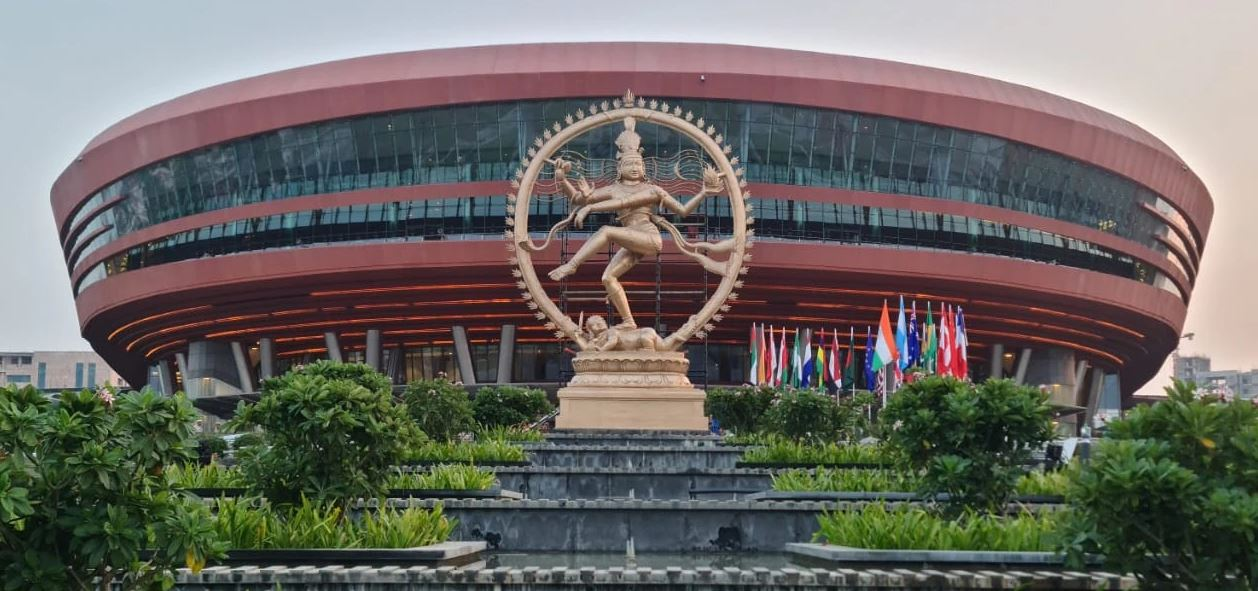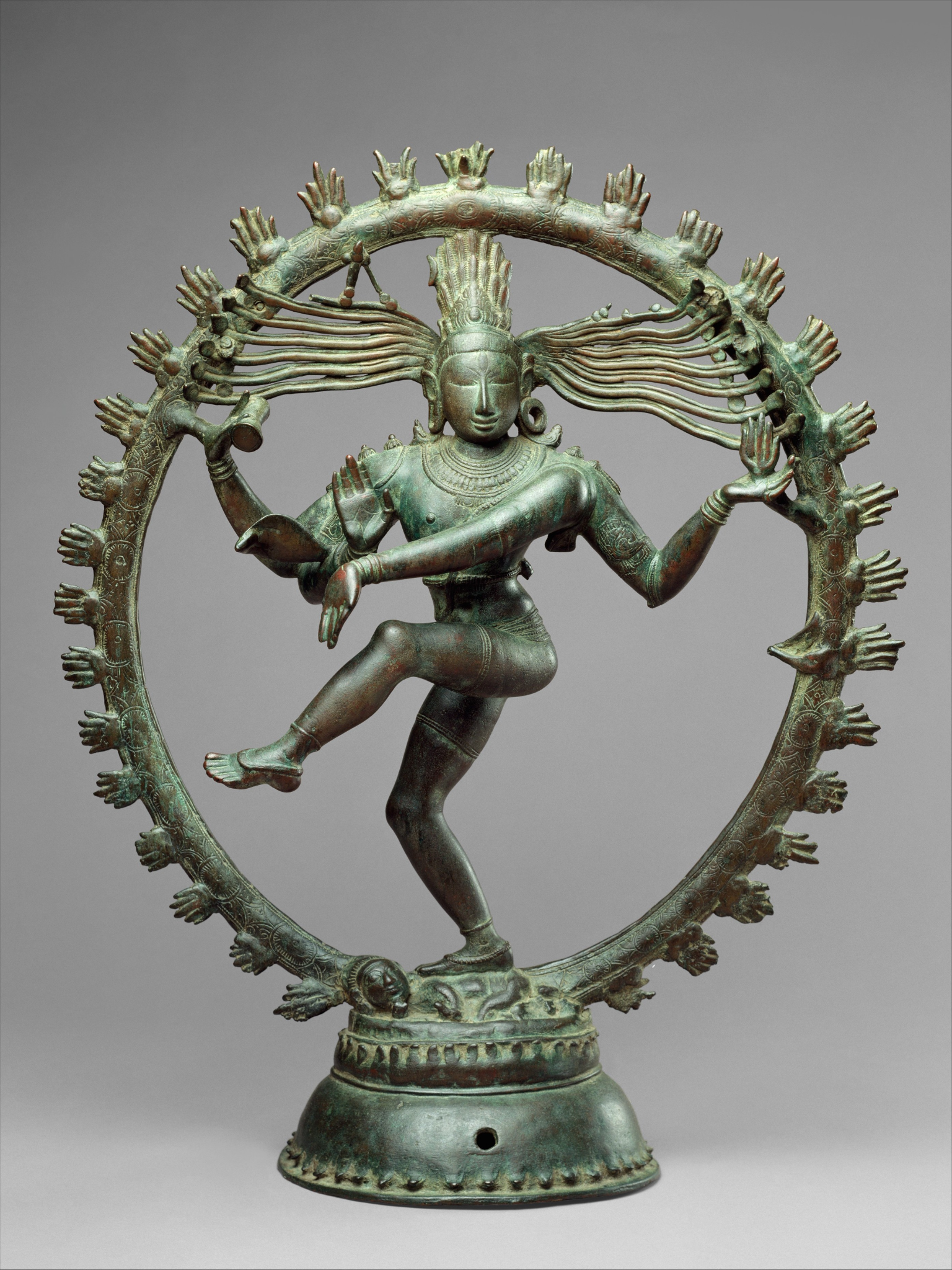Indian Heritage & Culture
Nataraja Artistry of Lord Shiva
- 12 Sep 2023
- 7 min read
For Prelims: Nataraja, Lost Wax Method
For Mains: Indian art heritage
Why in News?
Recently, The G20 Leaders' Summit at Bharat Mandapam, New Delhi, featured a stunning 27-foot Nataraja sculpture, the world's tallest representation of Lord Shiva in his dancing form.
What are the Key Highlights of the Nataraja Statue in Bharat Mandapam?
- This remarkable Nataraja statue, crafted from an ashtadhatu (eight-metal alloy) by artisans from Tamil Nadu, weighs 18 tonnes.
- The statue is sculpted by the renowned sculptor Radhakrishnan Sthapaty of Swami Malai in Tamil Nadu.
- The design of this Nataraja statue draws inspiration from three revered Nataraja idols: the Thillai Nataraja Temple in Chidambaram, the Uma Maheswarar Temple in Konerirajapuram, and the Brihadeeswara (Big) Temple, a UNESCO World Heritage Site, in Thanjavur. This offers a deep insight into the history and religious symbolism of Lord Shiva's dancing form.
- The Nataraja sculpture at Bharat Mandapam is made using the lost wax method.
What is the History and Religious Symbolism of Lord Shiva’s Dancing Form?
- Ancient Origins of Shiva:
- Shiva, one of the principal deities in Hinduism, has ancient roots that trace back to the Vedic period.
- In Vedic scriptures, Shiva's precursor is Rudra, a deity associated with natural elements, particularly storms, thunder, and the wild forces of nature.
- Rudra was initially a fierce and fearsome deity, embodying the destructive aspects of nature.
- Emergence of Nataraja Form:
- The concept of Shiva as a dancer, known as Nataraja, began to take shape around the 5th century AD.
- Early depictions of Shiva's dance laid the foundation for the multifaceted symbolism associated with the Nataraja form.
- Shiva Under the Cholas:
- During the reign of the Chola dynasty (9th-11th centuries AD), Shiva's Nataraja form underwent significant development.
- The Cholas, known for their patronage of art and culture, played a pivotal role in shaping Nataraja's cultural significance.
- The Cholas were devout Shaivites, emphasizing the worship of Lord Shiva.
- They constructed grand Shiva temples throughout their territories, with the Brihadeeswara Temple in Thanjavur being a prominent example. with a particular focus on Shaiva figures in their sculptures.
- Evolution of Nataraja Iconography:
- Nataraja's symbolism grew more complex under the Cholas.
- Lord Shiva is a complex deity in the Puranic pantheon, embodying both destructive and ascetic qualities.
- Nataraja, the 'Lord of Dance,' is celebrated for his invention of 108 diverse dances. The dancing Shiva became associated with both creation and destruction, embodying the dualities of life.
- The dance was seen as a cosmic dance, with Shiva as the cosmic dancer, and the world as the stage.
- Iconic Elements of Nataraja
- In iconic representations, Nataraja is depicted within a flaming aureole or halo, symbolizing the circle of the world.
- His long, flowing dreadlocks signify the energy and dynamism of his dance.
- Nataraja is typically shown with four arms, each holding symbolic objects that convey deeper meanings.
- Symbolism in Nataraja's Attributes:
- Nataraja holds a damru (hand drum) in his upper right hand, which draws all creatures into his rhythmic motion, and in his upper left arm, he wields Agni (fire), symbolizing his power to destroy the universe.
- Beneath one of Nataraja's feet lies a crushed dwarf-like figure, representing illusion and worldly distractions.
- In ornamentation, one ear of Shiva has a male earring while the other has a female.
- This represents the fusion of male and female and is often referred to as Ardhanarishwar.
- A snake is twisted around the arm of Shiva. The snake symbolises the kundalini power, which resides in the human spine in the dormant stage. If aroused, one can attain true consciousness.
- Nataraja as Protector and Reassurer:
- Despite the formidable symbolism associated with Nataraja, he also serves as a protector.
- The 'abhayamudra' (fear-allaying gesture) made with his front right hand reassures devotees, offering protection from fear and doubt.
- Nataraja's raised feet and his gesture with his front left-hand point to his feet, inviting devotees to seek refuge in him.
- Nataraja's Smile:
- One of the distinctive features of Nataraja's iconography is his almost always present broad smile.
- The French historian Renee Grousset beautifully described Nataraja's smile as representing both "death and life, both joy and pain."
What is the Lost Wax Method?
- Sculptors who created the Nataraja statue which is placed at the Bharat Mandapam, New Delhi, trace their lineage 34 generations back to the Cholas.
- The crafting process used is the traditional 'lost-wax' casting method, indigenous to the Chola era.
- The lost-wax method dates back at least 6,000 years, a copper amulet crafted using this method at a neolithic site in Mehrgarh, Balochistan (present day Pakistan) is dated to circa 4,000 BC.
- Notably, the Dancing Girl of Mohenjo Daro was also crafted using this technique.
- The lost-wax method dates back at least 6,000 years, a copper amulet crafted using this method at a neolithic site in Mehrgarh, Balochistan (present day Pakistan) is dated to circa 4,000 BC.
- This method involves creating a detailed wax model, coating it with alluvial soil, heating to burn away the wax, and filling the mold with molten metal.
- The Cholas excelled in the lost wax method for producing elaborate metallic sculptures.
- This technique was used to create intricate sculptures for millennia.






